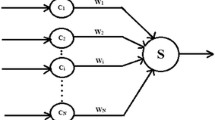Abstract
Atomic clocks work on a standard frequency generated by the electron transitions in the atoms of the core material. A timescale is a reference frequency and phase measure generated by a set of atomic clocks. An ensemble algorithm combines the participating atomic clocks to form a “perfect” clock. The perfect clock is very stable and precise in terms of frequency and phase. There are many methods that exist to develop an ensemble for a timescale such as Kalman filter-based algorithms, inverse Allan variance-based algorithms, etc. A neural network-based realization of the ensemble algorithm for a timescale is discussed in this paper. The artificial neural network (ANN) model dynamically adapts the weights of the clocks to accommodate the behavioural changes in the clocks. This paper uses different types of M-sample deviations like overlapping Allan deviation and overlapping Hadamard deviation as the inputs to the model.










Similar content being viewed by others
References
J. Nelson, “What is an Atomic Clock?” nasa.gov. http://www.nasa.gov/feature/jpl/what-is-an-atomic-clock.
Ahn, In Soo, “State modeling of clock noises and its application” (1986). Retrospective Theses and Dissertations. 8053. https://lib.dr.iastate.edu/rtd/8053.
S. Maharana, A. Bhardwajan, T. Ganesh and B. Ramakrishna, Timescale Ensemble Performance Enhancement Through Use of Artificial Neural Network, INCOSE Int. Symp. 29 (2019) 478–488. https://doi.org/10.1002/j.2334-5837.2019.00701.x.
P. Sherman, “Allan Variance” Iowa State University. http://home.engineering.iastate.edu/~shermanp/AERE432/lectures/Rate%20Gyros/Allan%20variance.pdf.
D.W. Allan, Historicity, Strengths, and Weaknesses of Allan Variances and their General Applications. Gyroscopy Navig. (2016).
W. Riley, and D.A. Howe, NIST Handbook of Frequency Stability Analysis. NIST Special Publication, 1065. 20899 (2008).
A. Bhardwajan, S. Maharana, and T. Ganesh, A Comparative Study of Methods of Clock Ensemble Development. MAPAN (2017). https://doi.org/10.1007/s12647-016-0197-x.
W.J. Riley, “3-corn Hat” wriley.com. http://www.wriley.com/3-CornHat.htm. Accessed 7 March 2020.
C. A. Greenhall, Likelihood and Least-squares Approach to M-Cornered Hat. PORC 1987 PTTI Meeting 9 (1987).
S. Podogova, K. Mishagin, Frequency Combining System for Atomic Clock Ensembles. (2014) https://doi.org/10.1109/eftf.2014.7331564.
Author information
Authors and Affiliations
Corresponding author
Additional information
Publisher's Note
Springer Nature remains neutral with regard to jurisdictional claims in published maps and institutional affiliations.
Rights and permissions
About this article
Cite this article
Sruthikeerthi Nandita, R., Maharana, S., Rajathilagam, B. et al. An Artificial Neural Network Model for Timescale Atomic Clock Ensemble Algorithm. MAPAN 35, 547–554 (2020). https://doi.org/10.1007/s12647-020-00414-0
Received:
Accepted:
Published:
Issue Date:
DOI: https://doi.org/10.1007/s12647-020-00414-0




